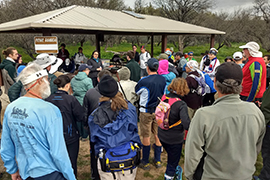- Slug: Sports-AZ Orienteering,810
- 2 photos available (thumbnails, captions below)
By Henry Greenstein
Cronkite News
PHOENIX – Ask Greater Phoenix Orienteering Club president Ron Birks what makes other states different from Arizona for orienteering, and he’ll answer in one word: “trees.”
In many places in the Arizona desert, Birks says, “You can see forever.” And that simply isn’t enough of a challenge for Birks and his fellow orienteers. They compete in a sport that tests both physical fitness and navigational skills, as participants use compasses and topographic maps to seek out destinations called controls as quickly as possible.
But orienteering in the desert is quite doable. It just relies on the mapmaking skill of those designing the courses.
“What we look for is things that are a little more undulating,” Birks said, “that have networks of gullies that we can put the destinations in so that the people have to actually use their navigation expertise.”
Arizona has much more than desert, and indeed in the summer Birks and his club flee the Phoenix heat and host events in Flagstaff, where there are trees aplenty. Cristina Luis, president of the Tucson Orienteering Club, said the diverse environments in the state make it possible to participate year-round.
“It’s actually a pretty great place for orienteering because we have such a variety,” she said, “and even though you wouldn’t want to orienteer down in the valleys in this time of year, we have all these different elevations.”
Both Birks and Luis are runners, with longstanding interests in maps (Birks collected topographic maps starting at the age of 8), who find orienteering much more entertaining.
“If you have to run a marathon, it’s just three and a half, four hours of just pavement,” Birks said, and it gets a little boring.” Luis similarly called running on road routes “mind-numbing.”
Contrastingly, there are countless sources of variety within orienteering. For one, the Phoenix club puts on different categories of courses: traditional point-to-point challenges, and events varyingly called “Score-O” or “rogaining” in which participants can self-select which points they want to travel to, within a fixed time limit. Not all courses are raced on foot, either. One upcoming event features a “Bike-O.”
Then there’s no shortage of terrain-dependent variation, in terms of elevation, foliage, vegetation and so on, to set orienteering apart from other sports.
“A tennis court in one place is very similar to a tennis court in another place,” said Bill Cusworth, an orienteer in the Bay Area. “I always use that as an example because I played tennis, but in this sport, every time you go somewhere, it’s all different.”
Cusworth has participated in orienteering events in about half the 50 states, as well as Scotland and Australia. His favorite course ever, he said, was at Riverside State Park near Spokane, Washington, a wide-open area with rocks he found interesting.
Cusworth said he was on the board of directors for national governing body Orienteering USA for six years, and currently takes part in a program creating orienteering maps for youth, through which he worked with Birks. He said despite a big youth push in the sport, it’s hard to attract kids’ attention.
“There’s so many different things out there competing for kids’ time,” he said. “It’s hard to get on their radar and make it sound like something that they’d want to do.”
Luis said her club’s membership is also primarily on the older side. She added that they’re eager to share the “secret” of orienteering, and unashamed of their participation in it.
“They probably don’t care that much what people think of them,” Luis said, “because they’re doing a weird sport, and you’re usually wearing weird clothing, and you’re, like, running around in the desert or forest or wherever you’re doing it.”
Or, as Cusworth assessed the community: “They’re all kind of geeky guys like me.”
The Tucson club has several built-in mechanisms for community outreach. Luis said they have a mailing list of about 700 people but only 30 members, so there’s plenty of opportunity for expansion. In addition, she has been “relentless” in recruiting members of her running club. Luis wants to host more events with short time limits so competitors can socialize before and after and compare notes.
She is also helping welcome newbies with introductory classes. There’s a lot to learn about orienteering, which requires a balance between physical and navigational capabilities that Luis said most people will say is about 50/50. Birks said it’s easy to lose track of your positioning when you “run like a gazelle.”
“The best results that I get are when I think I’m running too slow,” he said.
Both clubs have events coming later in July. The Tucson club has a Score-O coming on July 17 in Jesse Owens Park. And though recent Coconino National Forest closures forced a two-week postponement, the Phoenix club is heading to Thorpe Park for the 2021 Flagstaff Navigation Games on July 24.
For more stories from Cronkite News, visit cronkitenews.azpbs.org.
^__=
Cristina Luis was the course setter for the Cholla Chaser map at Southwest Spring Week in 2019. She says the group has about 30 consistent members but draws from a mailing list of 700. (Photo courtesy of B. Brooke Mann)
Ron Birks, right, addresses attendees at the Phoenix club’s Sundance Park Beginner’s Clinic on June 5. Attracting younger members is a priority from Orienteering USA on down. (Photo courtesy of the Greater Phoenix Orienteering Club)

